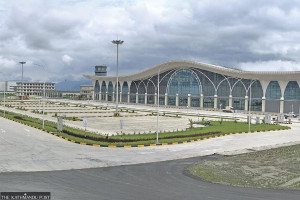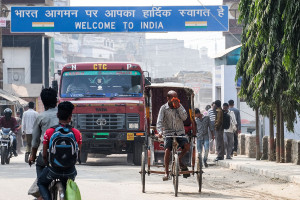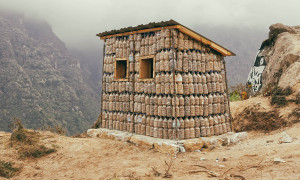Money
Dividend payment by state-owned enterprises drops to 13-year low
The low rate of return has raised questions over whether the government should keep throwing good money after bad to save poorly run companies.
Prithvi Man Shrestha
The dividend payment to the government by public enterprises in the last fiscal year 2021-22 was the lowest in 13 years, even though its investments have been growing over the same period, an official report revealed.
The low rate of return has once again raised questions over whether the government should keep throwing good money after bad to save poorly run companies that are perpetually in the red, experts said.
According to the Initial Annual report on Share and Loan Investment of the Government 2021-22 unveiled this week by the Public Debt Management Office, the government received only Rs4.24 billion in dividends from its companies in the last fiscal year.
This is the lowest dividend since the fiscal year 2008-09 when the government received Rs3.47 billion, official statistics show.
Dividends reached a 13-year high of Rs23.64 billion in the fiscal year 2019-20. Since then, the amount of dividends has been in a downward spiral, shrinking to Rs12.75 billion in fiscal 2020-21 and declining further in the following fiscal year.
While dividends have been in freefall, the government has been pumping more and more money into its companies to prop them up.
The government’s share investments came to Rs357.63 billion in 113 public enterprises as of the last fiscal year, up from Rs86.13 billion in 36 enterprises in 2008-09.
According to the Public Debt Management Office, the government has made investments totalling Rs733.85 billion, including shares and loans.
Among the government's myriad enterprises, only nine paid dividends in the last fiscal year, the report said. They are Nepal Telecom, Rastriya Banijya Bank, Agriculture Development Bank, Butwal Power Company, Nepal Stock Exchange, Salt Trading Corporation, Citizen Investment Trust, Civil Aviation Authority of Nepal and Sajha Sewa.
Nepal Telecom was the largest payer with Rs2.74 billion while Sajha Sewa paid all of Rs4,274.
“The data suggests that most public enterprises in which the government owns stock are not making a profit,” said Bimala Adhikari, undersecretary at the Public Debt Management Office overseeing the share and investment division.
“We collected the data based on dividends announced by the enterprises where the government has share investments.”
One reason behind the drop in dividends is that the contribution of historically major contributors like Nepal Telecom decreased. The telecommunication giant had paid as much as Rs6.86 billion in dividends to the government in fiscal 2015-16, according to the Annual Report on the Performance of Public Enterprises released by the Finance Ministry.
The Nepal Electricity Authority didn’t distribute dividends as it is yet to recover from its accumulated losses despite making impressive profits in fiscal 2020-21. In 2020-21, the power utility made a net profit of Rs6.10 billion, according to its annual report 2020-21. In 2011, the government had written off its Rs28 billion loss.
The utility continued wallowing in losses till 2015-16, and then made a turnaround in 2016-17 and earned a net profit of Rs1.46 billion, its first in more than a decade. The electricity authority's financial performance has been improving, but it is yet to overcome its cumulative losses.
“We are yet to recover our accumulated losses. That’s why we are barred from paying dividends,” said Lokendra Saud, chief of finance.
Section 182 of the Companies Act says that a company needs to deduct its accumulated losses and preoperative expenses, depreciation, and the amount it needs to set aside by law before paying dividends for any financial year.
“A number of state-owned companies have not made profits because the government has just invested in them,” said Adhikari. “Several government-invested hydropower projects and airport projects cannot pay dividends immediately.”
According to her, the amount of dividends paid to the government fell in the last fiscal year because Nepal Rastra Bank didn’t declare dividends as usual.
Bimal Wagle, former chairperson of the now-defunct Public Enterprises Board, said the financial performance of public enterprises was seesawing because most of them were not running efficiently.
“For example, Nepal Electricity Authority makes good profits when it is able to control leakage instead of expanding business,” he said. “Nepal Oil Corporation sometimes makes quick profits, but goes into the red equally fast.”
Experts say that the government mechanism is inefficient to run these enterprises, particularly commercial companies.
“The government cannot run the public enterprises efficiently, and there is no basis it can do so,” said economist Pushkar Bajracharya. “Because of the inefficiency of the government, public enterprises such as Birgunj Sugar Mill, Himal Cement, Janakpur Cigarette Factory and Gorakhkali Rubber Udyog were shut down.”
Even though the incompetence of the government in managing public enterprises is vividly apparent, there is no talk of privatisation nowadays. The last public enterprise to be privatised was Agriculture Lime Industry in December 2007, which till now remains closed.
Even though the government initiated the privatisation of a number of public enterprises from the early 1990s to the early 2000s, there is currently no appetite among the political leaders to go for privatisation. Particularly, the political parties are fearful of privatising public enterprises because of political risks.
Senior Nepali Congress leader Gagan Thapa complained during an interaction held by the Society of Economic Journalists on December 1 that his party is often blamed for selling government companies because of its privatisation drive.
Since the private sector too has not been able to revive the failed corporations, questions have been raised repeatedly about the rationale behind privatisation. A dozen public enterprises have shut down since being privatised, according to the Finance Ministry.
“Public enterprises have not been able to make a profit in obviously profitable sectors because of inefficiency. That is because political leaders have forced them to hire their party cadres instead of recruiting staff on merit basis,” said Wagle.
Despite all the money going down the drain, the government’s investment in public enterprises is growing. The government has been injecting capital into sick corporations even though it has been having a hard time collecting enough revenue to pay for recurrent expenditure.
Revenue collection as of December 17 of the current fiscal year stood at Rs329.46 billion while recurrent expenditure during the same period amounted to Rs357.60 billion, according to the Financial Comptroller General Office, which maintains the government’s income and expenditure data.
“Investing in loss-making entities means reducing resources for important development schemes at a time when the government has been unable to collect adequate revenue,” said Bajracharya.
“So, it is important for the government to give up investing in commercial enterprises and concentrate on enterprises providing public services.”




 18.12°C Kathmandu
18.12°C Kathmandu















